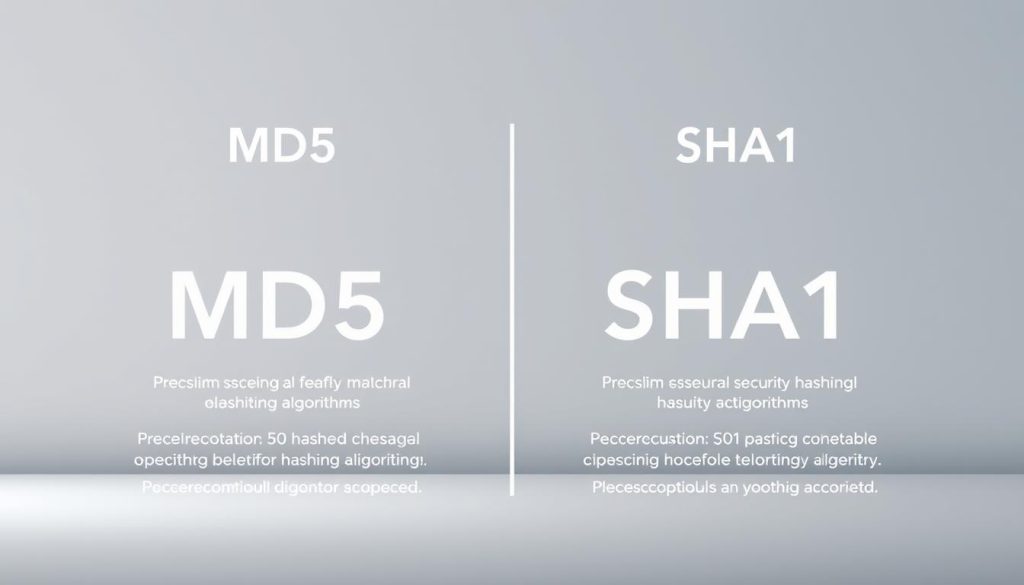Have you ever wondered if the digital files you download are exactly what they claim to be? In our interconnected world, ensuring data integrity is not just a technical concern—it’s a fundamental pillar of trust. This is where cryptographic hash functions come into play, acting as unique digital fingerprints for any piece of information.
We will explore two foundational pillars of data verification: MD5 and SHA1. These hashing algorithms were designed to convert input of any size into a fixed-length string of characters, known as a hash. This process is crucial for verifying that data has not been altered. For a deeper look at one of these methods, you can learn more about SHA1.
While both were once industry standards, their journeys have diverged due to evolving security landscapes. Understanding their strengths and weaknesses is essential for anyone responsible for protecting digital assets. We will break down their technical specs and practical uses in a clear, accessible way.
Key Takeaways
- Hashing algorithms create a unique digital fingerprint for data.
- MD5 and SHA1 are two historically important cryptographic tools.
- Both convert data into a fixed-length hash value for verification.
- Security vulnerabilities have impacted the recommended use of both algorithms.
- Knowing the distinction is critical for modern data integrity decisions.
- This guide will compare their speed, security, and real-world applications.
Introduction to Hashing Algorithms
Every piece of digital data can be assigned a unique, compact identifier through a process called hashing. This is the job of a hash function. We define these functions as mathematical algorithms that take an input of any size and produce a fixed-length string of characters, known as a hash value.
An ideal hash function operates with incredible speed. It also generates a massive range of possible outputs. For a 256-bit function, the number of potential hash values is comparable to the number of atoms in the universe. This vast space is crucial for avoiding collisions, where two different inputs produce the same hash value.
Overview of Hash Functions and Their Importance
These functions are designed to be highly sensitive. A tiny change in the input, like changing “fox” to “fax” in a sentence, results in a completely different hash. This property ensures that even similar data has distinct digital fingerprints.
Critically, a cryptographic hash function is a one-way operation. You cannot reverse the process to discover the original input from the hash. This one-way nature is a cornerstone of digital security.
Role in Data Integrity and Security
The primary role of these algorithms is to guarantee data integrity. By comparing hash values before and after transmission or storage, we can verify that the data remains unaltered.
This verification is vital for password storage, digital signatures, and file downloads. The fixed-length output of hash functions also makes them practical for efficient database searches and blockchain technology. Understanding these properties is key to evaluating specific algorithms.
What is MD5?
In 1991, a significant step forward in data fingerprinting emerged with the creation of the MD5 algorithm. Developed by Ronald Rivest as an enhancement to MD4, this cryptographic tool was designed for speed and reliability.
MD5 Definition and Key Features
We define MD5, which stands for Message Digest 5, as a function that processes input data of any length. It consistently produces a fixed-length output, known as a hash or digest, of 128 bits. This is often shown as a 32-character hexadecimal number.
The algorithm was built to be computationally complex to reverse. Breaking a single message digest would require an immense 2^128 operations. This made it a strong choice initially.
Applications, Advantages, and Limitations
MD5 used for non-security purposes remains common. Its primary applications include verifying file integrity. Download sites often provide an MD5 checksum so users can confirm their files are authentic and uncorrupted.
A key advantage is its speed. It is faster than many alternatives and simple to implement. Tools to generate MD5 hash values are built into most operating systems.
However, a major limitation is its vulnerability to collision attacks. Different inputs can produce the same 128-bit hash, compromising security. This is why modern comparisons of hash functions often show MD5 as insecure for protecting sensitive data. It is not recommended for new cryptographic systems, especially when compared to stronger options like the Secure Hash Algorithm family.
What is SHA1?
In 1995, a new cryptographic standard entered the landscape with the publication of SHA1 as a Federal Information Processing Standard. Designed by the United States National Security Agency, this secure hash algorithm was the successor to SHA0. It quickly became a cornerstone for digital security.
SHA1 Definition and Its 160-Bit Output
We define SHA1, which stands for Secure Hash Algorithm 1, as a function that processes data to create a unique fingerprint. It generates a fixed-length 160-bit hash value, known as a message digest.
This digest is typically shown as a 40-character hexadecimal number. The larger output size provides more possible combinations than earlier algorithms. This makes collisions, where two inputs create the same hash value, much harder to find.
Security Applications and Vulnerabilities
SHA1 was widely adopted for critical security tasks. Its applications included:
- Protecting sensitive communications from interception
- Verifying data integrity in finance and healthcare
- Creating digital signatures for document authentication
- Securing password storage systems
Major protocols like TLS, SSL, and IPSec relied on this algorithm. However, significant vulnerabilities were discovered over time. Since 2005, experts have considered it insecure against well-funded attacks.
Finding collision operations became relatively simple. This led to industry-wide calls for migration to stronger alternatives like SHA-256. The difference between MD5 and SHA1 in security ultimately proved insufficient for modern threats.
Difference between MD5 and SHA1
Choosing the right cryptographic function depends on recognizing the fundamental variations in their design and capabilities. We examine how these algorithms differ in their core specifications and practical performance.
Comparison of Digest Lengths and Performance
The naming conventions reveal their distinct purposes. MD5 stands for Message Digest, while SHA1 represents Secure Hash Algorithm. This reflects their different security focuses from the outset.
MD5 generates a 128-bit message digest, while SHA1 produces a 160-bit output. The longer digest length provides SHA1 with stronger theoretical collision resistance. However, MD5 operates significantly faster due to its simpler design.
Implications for Security and Practical Use
Security requirements show clear distinctions. Breaking an MD5 hash requires 2^128 operations, while SHA1 needs 2^160 operations. This makes SHA1 computationally more challenging for attackers.
Finding identical message digests takes 2^64 operations for MD5 versus 2^80 for SHA1. The greater complexity of SHA1’s algorithm contributes to its stronger security profile, though both have known vulnerabilities today.
These technical differences guide practical application choices. MD5’s speed suits non-security tasks, while SHA1’s enhanced security made it preferable for sensitive applications before stronger alternatives emerged.
Real-World Applications and Use Cases
The practical implementation of hash functions extends far beyond theoretical cryptography into everyday digital workflows. These algorithms serve critical roles across multiple industries where data integrity is paramount.
Usage in File Integrity and Software Distribution
One of the most common applications involves verifying downloaded files. When you download software packages or archives, providers often include a checksum value. This allows users to confirm their downloaded file matches the original exactly.
In Unix systems, users can generate MD5 checksums using commands like md5sum. Windows users employ PowerShell’s Get-FileHash command. The validation process provides immediate feedback, typically showing “OK” when files match perfectly.
This practice ensures transmitted data arrives uncorrupted. It’s widely used in software distribution, Android ROMs, and large file transfers.
Industry Standards and Cryptographic Practices
Beyond file verification, hashing plays vital roles in security systems. Digital signatures use hash values encrypted with private keys to authenticate documents. This establishes trust in electronic communications.
Password storage systems rely on hashing algorithms to protect credentials. Instead of storing plaintext passwords, systems store hash values for verification.
Critical sectors like finance and healthcare use these applications for data integrity checking. Despite current recommendations for stronger alternatives, these algorithms remain integrated into many established systems.
Comparative Analysis: Performance and Security
Performance metrics and security assurances form the essential criteria for assessing any hashing algorithm’s suitability. We examine how computational efficiency intersects with protective capabilities in real-world applications.
Speed Considerations and Operational Complexity
MD5’s design prioritizes processing speed through simpler mathematical operations. This algorithm completes hash generation faster, making it suitable for large data volumes where security isn’t critical.
SHA1 requires more complex computational steps, resulting in slower performance. The additional operations provide stronger collision resistance but demand greater processing time and resources.
Strengths, Weaknesses, and Future Recommendations
Both algorithms demonstrate significant security vulnerabilities against modern threats. Research shows collision attacks have become feasible and inexpensive with current computing power.
The National Institute of Standards and Technology recommends transitioning to SHA-256 for cryptographic applications. While this function operates 20-30% slower, it provides substantially stronger security protection.
For non-security purposes like basic file verification, these older algorithms remain acceptable. However, any sensitive data requires modern hashing functions like the SHA-256 algorithm to ensure adequate protection. A detailed comparison reveals why updated standards are essential for contemporary security needs.
Conclusion
Our exploration of foundational cryptographic tools reveals a clear evolutionary path in data protection. We have examined two pivotal hashing algorithms that shaped digital security for decades.
Each algorithm served a distinct purpose. One offered speed for basic checksums, while the other provided enhanced security for sensitive applications. Both were groundbreaking in their time.
However, technological progress exposed critical flaws in these cryptographic hash functions. Modern computing power has rendered their collision resistance insufficient for protecting vital information.
This understanding guides current best practices. For any system requiring robust data integrity, migrating to stronger algorithms like SHA-256 is essential. They offer the security needed in today’s landscape.
Knowledge of these historical tools remains valuable for maintaining legacy systems and making informed decisions. Our goal is to empower you with this clarity for your own security implementations.
FAQ
What is a hash function?
What are the main differences in output between MD5 and SHA1?
Why is MD5 considered insecure today?
In what situations might MD5 still be acceptable to use?
What are the common applications for SHA1?
Which algorithm is faster, MD5 or SHA1?
What should I use instead of MD5 or SHA1 for secure applications?
Hi, I’m Mark, the author of Clever IT Solutions: Mastering Technology for Success. I am passionate about empowering individuals to navigate the ever-changing world of information technology. With years of experience in the industry, I have honed my skills and knowledge to share with you. At Clever IT Solutions, we are dedicated to teaching you how to tackle any IT challenge, helping you stay ahead in today’s digital world. From troubleshooting common issues to mastering complex technologies, I am here to guide you every step of the way. Join me on this journey as we unlock the secrets to IT success.



